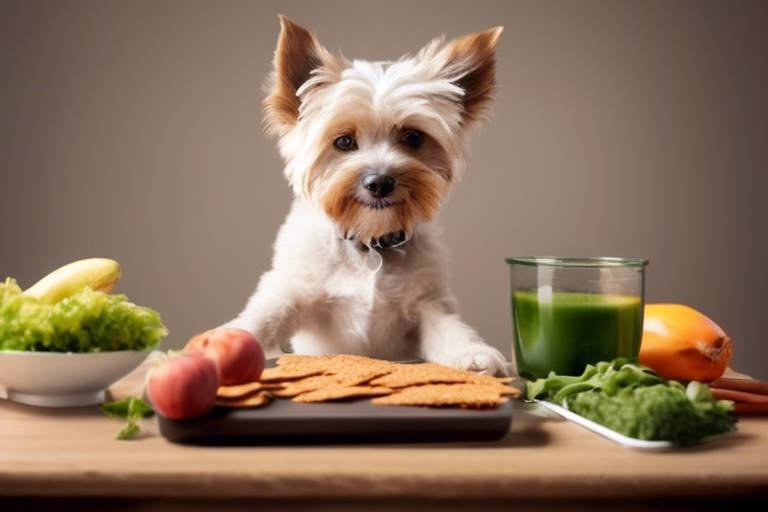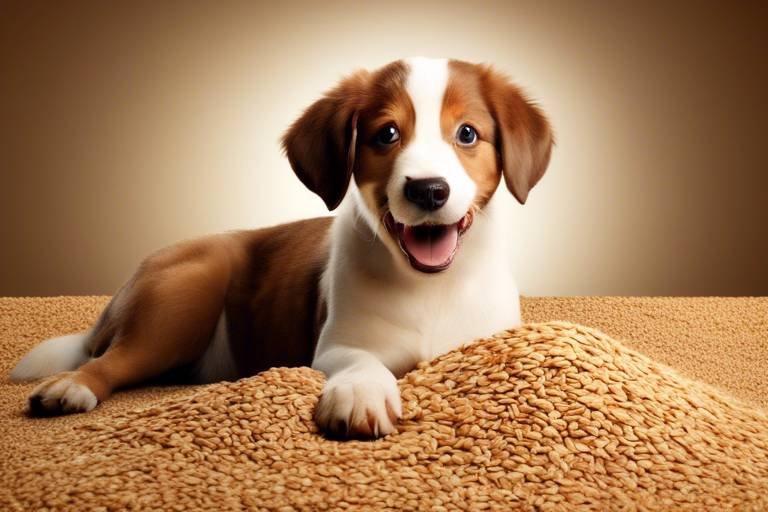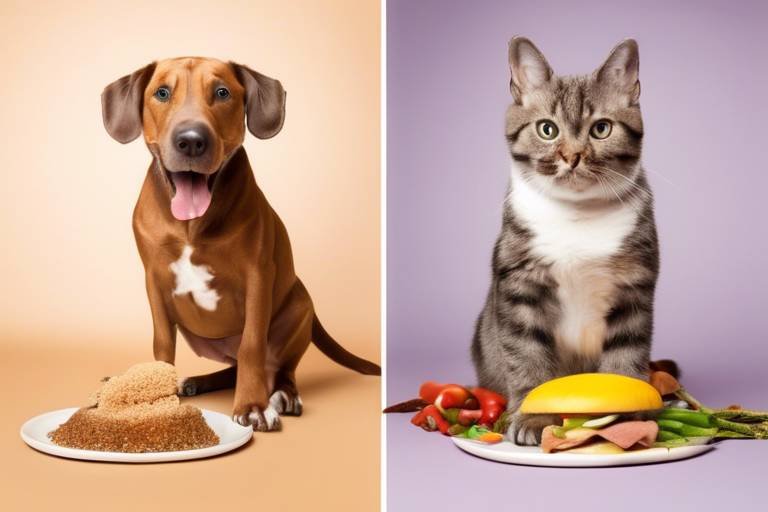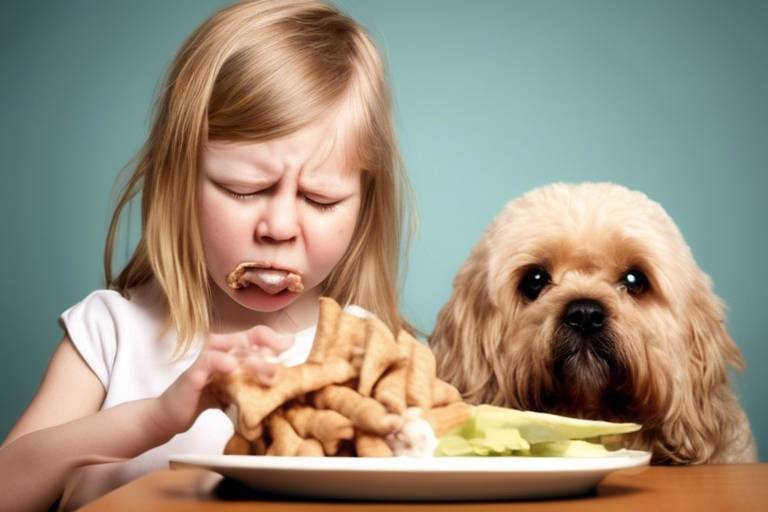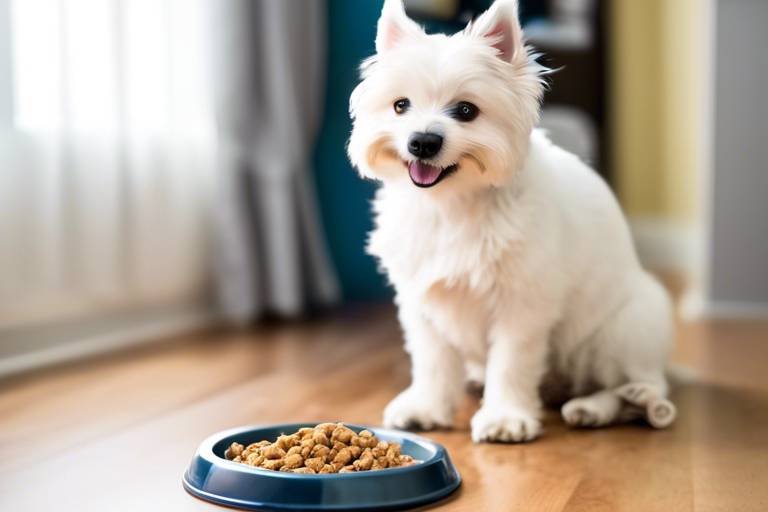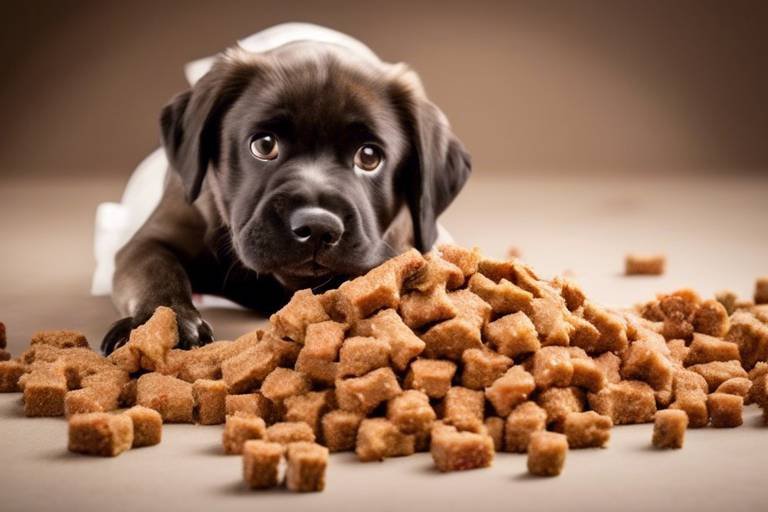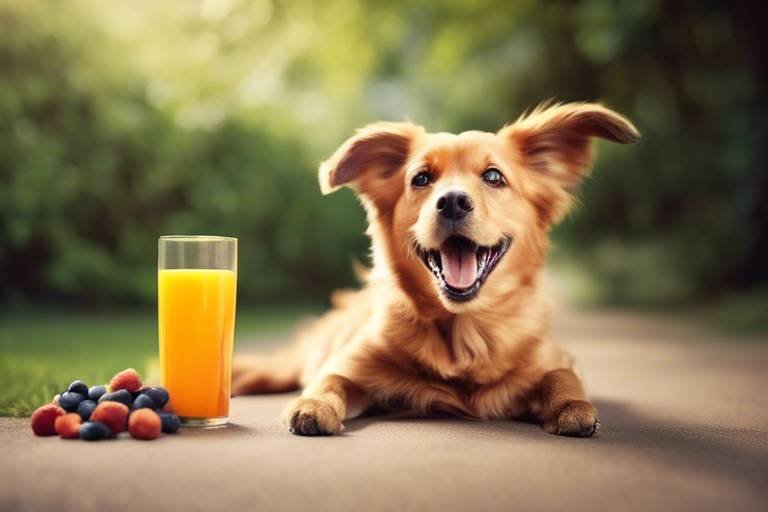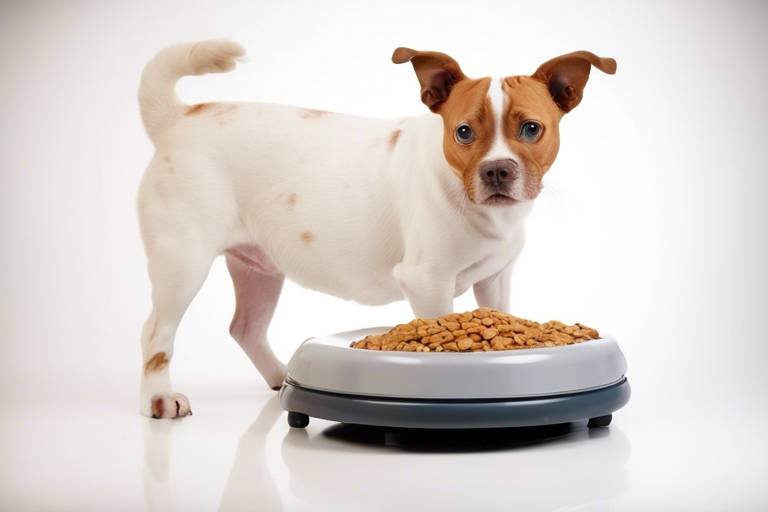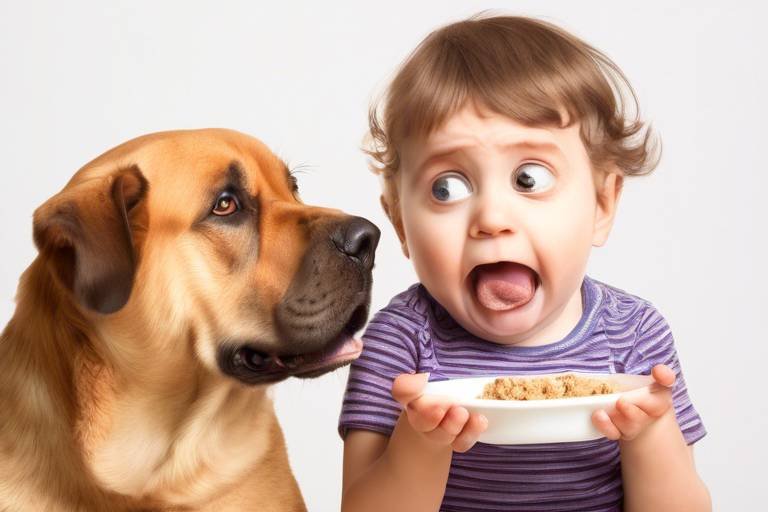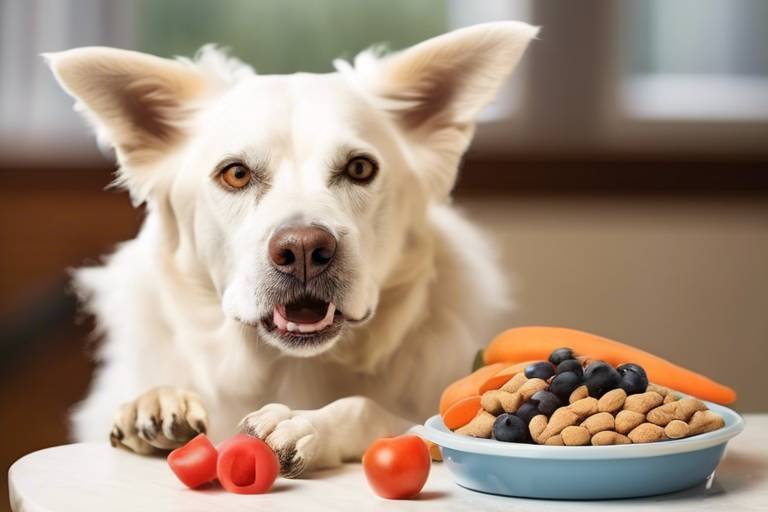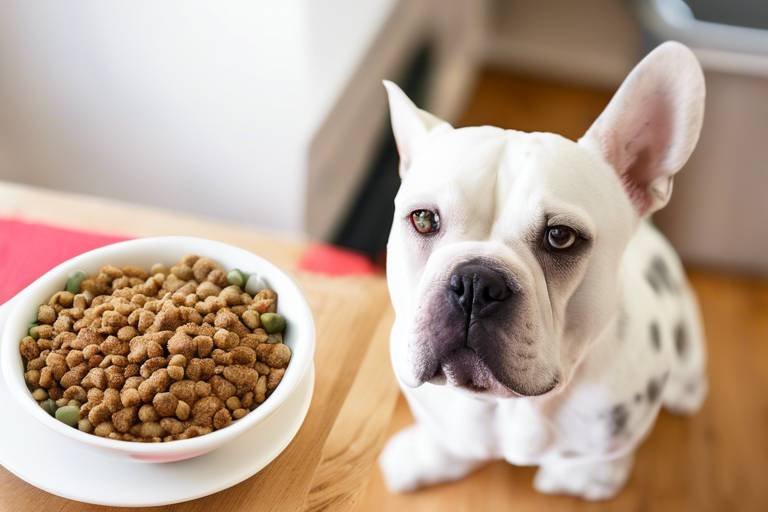Understanding the Risks of Feeding Pets Highly Processed Foods
As pet owners, we often want the best for our furry friends. However, in our quest for convenience, we may unknowingly expose them to the dangers of highly processed foods. These foods, often marketed as "complete" and "balanced," can be misleading. They might look appealing and promise all the necessary nutrients, but the reality can be quite different. The ingredients list may contain a concoction of additives, fillers, and low-quality proteins that could lead to serious health issues over time.
One of the most alarming aspects of highly processed pet foods is their potential to create nutritional deficiencies. Many of these foods are stripped of essential vitamins and minerals during the manufacturing process. Imagine feeding your pet a meal that lacks the vital nutrients they need to thrive; it's akin to giving a child candy instead of a balanced meal. Your pet may seem fine initially, but over time, these deficiencies can manifest in various health problems, affecting their energy levels, coat quality, and overall well-being.
Furthermore, the ingredients in processed pet foods often include artificial additives that can cause allergies and digestive issues. These substances are designed to enhance flavor, color, or shelf-life, but they can have detrimental effects on your pet's health. For instance, some pets may develop sensitivities to these additives, leading to chronic itching, gastrointestinal distress, or even more severe allergic reactions. It's crucial to remember that what goes into your pet's body matters, and just because something is palatable doesn't mean it's healthy.
Another concerning factor is the presence of fillers. These ingredients, often derived from low-quality sources, provide minimal nutritional value. Think of them as the empty calories in junk food for humans. While they may fill up your pet's stomach, they do little to nourish their body. Over time, a diet high in fillers can lead to weight gain, obesity, and related health issues such as diabetes and joint problems. Understanding the role of these fillers is essential when making dietary choices for your pet.
Ultimately, the risks associated with feeding pets highly processed foods are significant. From nutritional deficiencies to long-term health issues, the implications can be serious. It’s essential to be aware of what you’re putting in your pet’s bowl. By educating ourselves and choosing healthier alternatives, we can ensure that our beloved companions lead long, happy, and healthy lives.
- What are the signs that my pet may be suffering from a poor diet? Look for signs such as lethargy, poor coat quality, digestive issues, and frequent allergies.
- Can I switch my pet's diet suddenly to avoid processed foods? It's best to transition gradually to prevent digestive upset. Consult with your veterinarian for a suitable plan.
- Are homemade diets better for pets? Homemade diets can be healthier, but they require careful planning to ensure they meet nutritional needs.
- What should I look for on pet food labels? Look for high-quality protein sources, minimal fillers, and avoid artificial additives and preservatives.

The Nutritional Deficiencies in Processed Pet Foods
When it comes to feeding our beloved pets, the choices we make can have a profound impact on their health and happiness. Unfortunately, many pet owners are unaware that highly processed pet foods often contain significant nutritional deficiencies. These deficiencies can lead to a myriad of health problems, affecting everything from energy levels to overall well-being. It’s crucial to understand what’s missing in these foods so we can make informed decisions for our furry companions.
Processed pet foods are typically designed for convenience, often prioritizing shelf life over nutritional value. This means that many essential nutrients are either absent or significantly reduced during the manufacturing process. For instance, vitamins, minerals, and amino acids are critical for maintaining your pet's health, yet they can be compromised in processed formulas. A diet lacking in these vital nutrients can lead to deficiencies that manifest in various health issues, such as:
- Skin problems - Poor coat quality and skin irritations can arise from inadequate fatty acids.
- Digestive issues - Lack of fiber can lead to constipation or diarrhea.
- Weakened immune system - Insufficient vitamins can make pets more susceptible to illnesses.
Moreover, the processing methods used in creating these foods often strip away natural nutrients. For example, the heat used during cooking can destroy delicate vitamins, while artificial fortification may not provide the same benefits as whole food sources. It’s a bit like trying to run on empty—without the right fuel, your pet simply won’t thrive.
One of the most alarming aspects of processed pet foods is the reliance on fillers and low-quality ingredients. These components may provide bulk but offer little in terms of nutrition. Common fillers include corn, wheat, and soy, which can fill your pet's stomach but leave them feeling unsatisfied and undernourished. In fact, a study has shown that pets consuming diets high in fillers are more likely to experience obesity and related health issues.
To put it simply, feeding your pet highly processed foods is like giving them a fast-food diet. It might be easy and convenient, but it lacks the essential nutrients they need to lead a healthy and active life. So, what can we do to ensure our pets are getting the nutrition they deserve? The answer lies in education and awareness.
By understanding the nutritional gaps in processed pet foods, owners can begin to explore healthier alternatives. This might include incorporating whole foods or high-quality commercial diets that prioritize natural ingredients. Making these changes can lead to a happier, healthier pet—one that has the energy to play, the vitality to thrive, and the longevity we all desire for our furry friends.
1. What are the signs that my pet may be suffering from nutritional deficiencies?
Common signs include poor coat condition, lethargy, digestive issues, and frequent illnesses. If you notice any of these symptoms, it may be time to reassess your pet's diet.
2. Are there specific ingredients I should look for in pet food?
Yes! Look for high-quality protein sources, whole grains, and a variety of fruits and vegetables. Avoid foods with fillers like corn and soy, as well as artificial additives.
3. Can I transition my pet from processed food to a natural diet?
Absolutely! Gradually introduce natural foods to your pet's diet while monitoring their response. It’s always best to consult with a veterinarian for personalized guidance.
4. How can I ensure my pet’s diet is balanced?
Consider consulting with a veterinarian or a pet nutritionist who can help you create a balanced meal plan tailored to your pet’s specific needs.

Common Ingredients to Avoid
When it comes to choosing the right food for your beloved pets, it’s crucial to be aware of common ingredients found in highly processed pet foods that can be harmful to their health. Many pet owners may not realize that certain ingredients can have detrimental effects, leading to a myriad of health issues. By understanding what to look out for, you can make informed decisions that contribute to your pet's overall well-being.
First and foremost, artificial additives are a significant concern. These chemicals are often used to enhance flavor, color, or shelf life but can lead to serious health problems, including allergies and digestive issues. For instance, many pet foods contain artificial colors and flavor enhancers that may cause hyperactivity or allergic reactions in sensitive pets. If you see ingredients like Red 40 or Yellow 5, it might be best to steer clear.
Another ingredient to watch out for is low-quality fillers. These are often used to bulk up the food without providing any real nutritional value. Common fillers include corn gluten meal, wheat by-products, and soybean meal. While they might make the food cheaper to produce, they can lead to weight gain and other health issues. In fact, many pets thrive on diets that are low in fillers, as these ingredients can cause digestive problems and contribute to obesity.
Preservatives are also a major concern in processed pet foods. While they are necessary to extend shelf life, many synthetic preservatives can be harmful. Ingredients like BHA (Butylated Hydroxyanisole) and BHT (Butylated Hydroxytoluene) have been linked to health issues, including cancer. Instead, seek out foods that use natural preservatives like vitamin E and vitamin C, which are safer options that don’t compromise your pet's health.
Lastly, low-quality protein sources can severely impact your pet's diet. Ingredients like meat by-products or animal digest may sound like they provide protein, but they often come from questionable sources. High-quality protein is essential for your pet’s growth and energy levels. Look for specific meat sources, such as chicken, beef, or salmon, listed as the first ingredient.
To summarize, here are the ingredients you should avoid when selecting pet food:
- Artificial additives (colors and flavor enhancers)
- Low-quality fillers (corn, wheat, and soy)
- Harmful preservatives (BHA and BHT)
- Low-quality protein sources (meat by-products)
By being vigilant about these ingredients, you can make better dietary choices for your furry friends and ensure they lead healthier, happier lives. Remember, your pet relies on you to provide them with the best nutrition possible, and understanding what's in their food is a vital part of that responsibility.
Q1: What are artificial additives, and why should I avoid them?
Artificial additives are chemicals used to enhance the flavor, color, or shelf life of pet food. They can lead to health issues such as allergies and digestive problems, making it wise to choose foods without these substances.
Q2: How can I identify low-quality fillers in pet food?
Low-quality fillers often include ingredients like corn gluten meal, wheat by-products, and soybean meal. If these are listed among the first ingredients, it’s best to look for alternatives with higher nutritional value.
Q3: Are there safe preservatives for pet food?
Yes, natural preservatives such as vitamin E and vitamin C are safer options compared to synthetic preservatives like BHA and BHT. Always check the ingredient list for these healthier alternatives.
Q4: Why is high-quality protein important for my pet?
High-quality protein is essential for your pet’s growth, energy, and overall health. It supports muscle development and provides the necessary nutrients for a balanced diet.
The Role of Artificial Additives
When it comes to our furry friends, we naturally want the best for them, right? However, many pet owners might not realize that artificial additives in processed pet foods can pose significant health risks. These additives, which include preservatives, colorings, and flavor enhancers, are often included to improve the appearance and shelf life of the food, but they can come at a steep cost to your pet's health.
Let's break it down a bit. Artificial additives can lead to a range of health issues, from digestive problems to skin allergies. For example, some pets may develop sensitivities to certain colorings, resulting in itchy skin or gastrointestinal distress. Imagine feeding your beloved dog a meal that looks appealing but is actually causing them discomfort—it's a heartbreaking scenario that no pet owner wants to face.
Moreover, these additives can disrupt the natural balance of nutrients in your pet's diet. Instead of providing wholesome, nourishing ingredients, many processed foods rely heavily on these artificial components to make their products more palatable. This reliance on additives means that your pet may not be getting the essential nutrients they need for optimal health. In fact, research has shown that diets high in artificial additives can lead to long-term health issues, such as obesity and chronic diseases.
So, how can you identify these harmful substances? It all comes down to reading labels. When you pick up a bag of pet food, take a moment to check the ingredient list. Look for terms like “artificial flavors”, “artificial colors”, and specific preservatives such as BHA and BHT. If you see these ingredients listed, it might be a good idea to put that product back on the shelf and consider a healthier alternative.
In addition to causing direct health problems, artificial additives can also impact your pet's behavior. Some studies suggest that certain preservatives can lead to hyperactivity in pets, similar to the effects seen in children who consume high amounts of artificial additives. This can create a challenging environment for both pets and their owners, leading to frustration and confusion.
Ultimately, the role of artificial additives in processed pet foods is a critical concern for any responsible pet owner. By being aware of these substances and their potential effects, you can make more informed choices about your pet's diet. Remember, a little knowledge goes a long way in ensuring that your furry companion leads a healthy and happy life.
- What are artificial additives?
Artificial additives are synthetic substances added to pet food to enhance flavor, color, or shelf life. Common examples include artificial flavors, colors, and preservatives.
- How can I tell if a pet food contains artificial additives?
Always check the ingredient list on the packaging. Look for terms like "artificial flavors," "artificial colors," and specific preservatives such as BHA and BHT.
- Are there natural alternatives to artificial additives?
Yes! Many brands now offer natural pet foods that use whole ingredients without artificial additives. Look for options that list real meat, fruits, and vegetables as primary ingredients.
- Can artificial additives affect my pet's behavior?
Yes, some studies suggest that certain artificial additives may lead to hyperactivity or behavioral issues in pets, similar to effects seen in children.
Understanding Preservatives
When it comes to pet food, preservatives are the unsung heroes—or villains, depending on your perspective. These substances are added to pet food to extend its shelf life, ensuring that the kibble in your pantry stays fresh until you're ready to serve it. However, while preservatives can prevent spoilage, they often come with a host of potential downsides that pet owners should be aware of.
Many commercial pet foods utilize artificial preservatives like BHA (butylated hydroxyanisole), BHT (butylated hydroxytoluene), and ethoxyquin. These compounds can keep the food from going rancid, but they may also pose health risks to your furry friends. Studies have indicated that some artificial preservatives could be linked to various health issues, including allergies, liver damage, and even cancer in the long run. It’s essential to weigh these risks against the benefits of a longer shelf life.
On the flip side, there are natural preservatives such as vitamin E (often listed as mixed tocopherols) and vitamin C (ascorbic acid) that can also help maintain freshness without the associated health risks. These natural alternatives not only serve their purpose but also provide additional health benefits to your pets. For instance, vitamin E is known for its antioxidant properties, which can help support your pet's immune system.
So, how can you make the best choice when it comes to preservatives in your pet's food? Here are a few tips:
- Read the Label: Always check the ingredient list for preservatives. If you see names you can't pronounce or that sound like they belong in a chemistry lab, it might be a red flag.
- Opt for Natural: Whenever possible, choose pet foods that use natural preservatives. They may be a bit pricier, but your pet's health is worth it.
- Consult Your Vet: If you're unsure about the best dietary choices for your pet, your veterinarian can provide tailored advice based on your pet's specific needs.
Ultimately, being aware of the preservatives in your pet's food is a crucial step in ensuring their health and well-being. While it's tempting to choose the most convenient option, taking the time to understand what goes into your pet's food can make a world of difference in their quality of life.
Q: What are the most common preservatives found in pet food?
A: Common preservatives include BHA, BHT, and ethoxyquin, which are artificial, as well as natural options like vitamin E and vitamin C.
Q: Are natural preservatives better for my pet?
A: Yes, natural preservatives generally have fewer associated health risks compared to artificial ones, making them a safer choice for your pet.
Q: How can I tell if the pet food I buy is safe?
A: Always read the ingredient label, look for natural preservatives, and consult your veterinarian for recommendations.
Impact of Fillers on Nutrition
When it comes to pet food, fillers are often sneaked in under the radar, and they can have a significant impact on your furry friend's nutrition. These fillers, which include ingredients like corn, wheat, and soy, are primarily used to bulk up the product and reduce production costs. While they may make the food look more appealing on the packaging, they offer minimal nutritional value. Think of fillers as the empty calories in a human diet—consuming them might fill your pet's stomach, but they do little to nourish their body.
One of the biggest concerns with fillers is their potential to contribute to weight gain. Since fillers are often high in carbohydrates and low in essential nutrients, pets consuming these foods may feel full but are not getting the vital proteins, vitamins, and minerals they need. This can lead to obesity, which is a growing epidemic among pets. In fact, according to the Association for Pet Obesity Prevention, over 50% of dogs and cats in the U.S. are classified as overweight or obese. This staggering statistic highlights the urgent need for pet owners to scrutinize the ingredients in their pet's food.
Moreover, fillers can also lead to digestive issues. Pets may struggle to break down these low-quality ingredients, resulting in gastrointestinal discomfort, gas, and irregular bowel movements. Just like humans can feel sluggish after a meal of junk food, pets can experience similar effects when their diets are filled with fillers. It's essential to remember that our pets thrive on high-quality, nutrient-dense foods that support their overall health and energy levels.
To help pet owners make informed decisions, here’s a quick comparison table illustrating common fillers versus healthier alternatives:
| Fillers | Healthier Alternatives |
|---|---|
| Corn | Brown rice |
| Wheat | Quinoa |
| Soy | Peas |
In conclusion, it's vital for pet owners to be vigilant about the fillers in their pet's food. Not only do these ingredients provide little to no nutritional benefits, but they can also lead to serious health problems down the line. By choosing high-quality pet food that prioritizes real meat, vegetables, and wholesome grains, you can ensure that your pet receives the balanced diet they deserve. Remember, a well-nourished pet is a happy and healthy pet!
- What are fillers in pet food? Fillers are low-quality ingredients used to bulk up pet food without providing essential nutrients.
- How can fillers affect my pet's health? Fillers can lead to obesity, digestive issues, and overall poor health due to their lack of nutritional value.
- What should I look for in a high-quality pet food? Look for real meat as the first ingredient, whole grains, and a variety of fruits and vegetables for balanced nutrition.
- Are there any specific fillers I should avoid? Yes, avoid fillers like corn, wheat, and soy, which are common in many processed pet foods.
Recognizing Low-Quality Proteins
When it comes to keeping our furry friends healthy, the quality of their protein sources is paramount. Unfortunately, many commercial pet foods are packed with low-quality proteins that can do more harm than good. But how do you spot these sneaky ingredients? It's not as daunting as it sounds! By understanding what constitutes a low-quality protein, you can make better choices for your pet's diet.
Low-quality proteins often come from sources that are not biologically appropriate for pets. For instance, ingredients like meat by-products or animal digest may sound innocuous but can be misleading. These ingredients can include leftover parts of animals that are not suitable for human consumption, such as feathers, beaks, and other non-meat components. While they do provide some protein, the nutritional value is significantly lower than that of high-quality, whole meat sources.
Here are some key indicators to help you identify low-quality proteins:
- Vague Descriptions: If the label lists "meat" without specifying the type (e.g., chicken, beef), it's a red flag. Always look for specific meat sources.
- By-Products: Ingredients labeled as "by-products" or "meal" can indicate lower quality. For instance, "chicken by-product meal" may contain parts that lack essential nutrients.
- Plant Proteins: While some plant proteins can be beneficial, they should not be the primary protein source. Ingredients like corn gluten meal or soy protein isolate are often fillers that lack the amino acids necessary for your pet's health.
Understanding the difference between protein sources is crucial. High-quality proteins, such as whole meats and fish, provide essential amino acids that are vital for your pet's growth, energy, and overall health. These proteins support muscle development and a healthy immune system, making them far superior to their low-quality counterparts.
Additionally, consider the protein digestibility of the ingredients used. High-quality proteins are more easily digested and absorbed by your pet's body, leading to better nutrient utilization and fewer digestive issues. On the other hand, low-quality proteins can lead to gastrointestinal distress, resulting in symptoms like vomiting, diarrhea, and even long-term health complications.
In summary, recognizing low-quality proteins in pet food is essential for ensuring your pet receives the best nutrition possible. Always read labels carefully, look for specific meat sources, and avoid vague terms. By making informed choices, you can help your furry friend thrive and enjoy a longer, healthier life.
1. What are some examples of high-quality protein sources for pets?
High-quality protein sources include whole meats like chicken, beef, lamb, and fish. Look for specific names on the ingredient list to ensure you're providing the best nutrition.
2. Can low-quality proteins harm my pet's health?
Yes, low-quality proteins can lead to nutritional deficiencies, digestive issues, and long-term health problems. It's important to choose pet foods with high-quality protein sources.
3. How can I ensure my pet is getting enough protein?
Consult your veterinarian for personalized dietary recommendations based on your pet's age, size, and health conditions. They can help you determine the right amount and sources of protein for your furry friend.
4. Is homemade pet food a better option for protein quality?
Homemade pet food can provide better control over ingredients, allowing you to choose high-quality protein sources. However, it's essential to ensure the diet is balanced and meets all your pet's nutritional needs.

Health Risks Associated with Processed Foods
Feeding your beloved pets highly processed foods can lead to a variety of serious health issues that every pet owner should be aware of. It's not just about convenience; the long-term effects of these diets can be detrimental to your furry companions. For instance, the prevalence of obesity has skyrocketed in pets, and much of this can be attributed to the consumption of processed foods that are often high in calories and low in nutritional value. But what does this mean for your pet’s health? Let’s dive deeper into the potential risks.
Obesity is more than just a weight issue; it can lead to a cascade of health problems. Pets that are overweight are at a higher risk of developing conditions such as diabetes, joint issues, and even heart disease. Imagine your pet struggling to keep up during playtime, panting heavily while simply walking around the house. This is a common scenario for pets suffering from obesity, and it can severely impact their quality of life.
Long-term consumption of processed foods can also lead to chronic health issues. Many of these diets are laden with harmful ingredients that can gradually wear down your pet's body. For example, the high levels of sugar and unhealthy fats found in many commercial pet foods can result in diabetes and other metabolic disorders. The reality is that these conditions can lead to a much shorter lifespan for your pet, which is something no pet owner wants to face.
Furthermore, digestive problems are another significant concern. Many processed pet foods contain fillers and low-quality ingredients that can disrupt your pet's digestive system. Pets may experience symptoms like vomiting, diarrhea, or even constipation. It's like feeding a child junk food every day; eventually, their body will protest. When pets consume diets lacking in real nutrients, they can develop food sensitivities or intolerances, leading to uncomfortable and sometimes severe gastrointestinal issues.
To illustrate the risks associated with processed pet foods, let’s take a look at a comparison of potential health issues:
| Health Issue | Causes | Potential Symptoms |
|---|---|---|
| Obesity | High-calorie processed foods | Weight gain, lethargy, difficulty breathing |
| Diabetes | Excessive sugar intake | Increased thirst, frequent urination, weight loss |
| Digestive Problems | Poor-quality fillers | Vomiting, diarrhea, bloating |
In conclusion, being aware of the health risks associated with feeding your pets highly processed foods is crucial for responsible pet ownership. It's essential to recognize that what we feed our pets directly impacts their overall health and happiness. By opting for healthier, more natural food choices, you can help prevent these serious health issues and ensure your furry friends live long, vibrant lives.
- What are the signs that my pet is overweight? Look for difficulty in breathing, reluctance to play, and noticeable fat deposits around the abdomen.
- How can I transition my pet to a healthier diet? Gradually mix in the new food with the old one over a week or two, monitoring for any digestive issues.
- Are there specific ingredients I should avoid in pet food? Yes, avoid foods with artificial additives, low-quality fillers, and excessive sugars.
Obesity and Its Consequences
Obesity in pets is becoming an alarming trend that many pet owners are unfortunately overlooking. Just like in humans, excess weight can lead to a myriad of health problems for our furry friends. When pets consume highly processed foods, they often ingest more calories than they burn, leading to weight gain. But what exactly does this mean for their overall health? Let's dive into the consequences of obesity in pets.
First and foremost, obesity can significantly shorten your pet's lifespan. Studies have shown that overweight pets are at a higher risk of developing serious health conditions, including:
- Diabetes: Excess weight can lead to insulin resistance, making it difficult for your pet to regulate blood sugar levels.
- Joint Issues: The additional weight puts extra strain on joints, leading to arthritis and mobility problems.
- Heart Disease: Just like humans, pets can suffer from heart problems due to obesity, which may result in heart failure.
- Respiratory Problems: Overweight pets often struggle to breathe properly, especially during physical activity.
Moreover, obesity can also affect your pet's mental health. Pets that are overweight may experience lower energy levels, leading to decreased playfulness and social interaction. This can result in boredom and anxiety, further exacerbating their condition. Imagine how you feel after a long day of indulgence; pets experience similar feelings when they aren't active and engaged.
To put things into perspective, let’s consider the analogy of a car. If you keep filling up a car with fuel without ever taking it out for a drive, it becomes overloaded and inefficient. Similarly, when pets are overfed but not exercised, they become lethargic and face numerous health challenges. It’s crucial to keep our pets active and maintain a balanced diet to prevent obesity.
So, what can you do as a responsible pet owner? Regular exercise is key! Aim for daily walks, playtime, and engaging activities that can help your pet shed those extra pounds. Additionally, monitoring your pet's diet and consulting with your veterinarian can help create a tailored weight management plan. Remember, a happy and healthy pet is a well-exercised pet!
Q1: How can I tell if my pet is overweight?
A: You can assess your pet's weight by checking their body condition score. You should be able to feel their ribs without excessive pressure, and they should have a defined waist when viewed from above.
Q2: What are some healthy treats for my pet?
A: Instead of high-calorie treats, consider offering fresh fruits and vegetables, like carrot sticks or apple slices, in moderation.
Q3: How much exercise does my pet need?
A: Generally, dogs need at least 30 minutes to 2 hours of exercise daily, depending on their breed and age. Cats also benefit from playtime and should be encouraged to engage in activities that stimulate their natural hunting instincts.
Long-term Health Issues
Feeding your beloved pets highly processed foods may seem convenient, but the long-term health issues that can arise from such diets are anything but trivial. Just like us, our furry friends need a balanced and nutritious diet to thrive. Over time, a diet rich in artificial ingredients, fillers, and low-quality proteins can lead to chronic health problems that significantly affect their quality of life.
One of the most concerning issues is the increased risk of metabolic disorders. Pets consuming highly processed diets are more prone to conditions such as diabetes and obesity. These aren't just cosmetic concerns; they can lead to severe complications, including heart disease and joint problems. Imagine your pet's once-vibrant energy dwindling, replaced by lethargy and discomfort. This scenario isn't just a possibility; it's a reality for many pets on poor diets.
Additionally, the long-term consumption of these foods can lead to digestive issues. Pets may experience chronic gastrointestinal problems, including diarrhea, constipation, and bloating. These symptoms can often be misattributed to other causes, but the root of the problem often lies in their diet. A healthy gut is essential for overall health, and when the digestive system is compromised, it can lead to a cascade of other health issues.
Moreover, the accumulation of toxins from artificial additives and preservatives can have detrimental effects over time. These substances can build up in your pet's system, leading to organ dysfunction and other serious health concerns. For instance, certain preservatives have been linked to liver and kidney problems, which can be life-threatening. Understanding the long-term consequences of these ingredients is crucial for making informed dietary choices for your pets.
In summary, the risks associated with feeding highly processed pet foods extend far beyond immediate health concerns. The long-term implications can lead to chronic health issues that affect not only your pet's lifespan but also their quality of life. As responsible pet owners, it’s our duty to ensure that our furry companions receive the best nutrition possible. By being proactive and transitioning to healthier food options, we can help mitigate these risks and promote a happier, healthier life for our pets.
- What are the signs that my pet may be suffering from poor nutrition?
Look for signs such as lethargy, obesity, digestive issues, and a dull coat. If you notice these symptoms, it may be time to reevaluate your pet's diet.
- Can I transition my pet to a healthier diet gradually?
Yes! Gradual transitions are often best to avoid digestive upset. Start by mixing a small amount of the new food with their current food and gradually increase the new food over several days.
- Are homemade diets safe for pets?
Homemade diets can be safe and nutritious if prepared correctly. It's essential to ensure that they are balanced and meet your pet's nutritional needs. Consulting with a veterinarian can help guide you.

Exploring Natural and Whole Food Alternatives
Transitioning your pet to a natural and whole food diet can be one of the best decisions you make for their health and well-being. In a world where highly processed pet foods dominate the market, it’s essential to understand the benefits of a more wholesome approach to feeding our furry friends. By opting for natural ingredients, you can ensure that your pet receives the nutrients they need to thrive, avoiding the pitfalls of artificial additives and low-quality fillers that are so common in commercial pet foods.
One of the most significant advantages of a natural diet is the improvement in your pet's overall health. Pets that consume whole foods often exhibit better digestion, increased energy levels, and healthier skin and coat. These benefits stem from the inclusion of fresh, whole ingredients that are rich in vitamins, minerals, and essential fatty acids. Unlike processed foods, which can be stripped of their nutritional value during manufacturing, whole foods retain their natural goodness, providing a balanced diet that supports your pet's immune system and vitality.
When considering a natural diet for your pet, you might be surprised at how simple it can be to implement. A raw food diet, for example, consists of uncooked meat, bones, fruits, and vegetables. This approach mimics the natural diet of wild canines and felines, offering a range of health benefits, including:
- Improved digestion: Raw foods are easier for pets to digest, leading to less gastrointestinal upset.
- Healthier weight: Whole foods can help maintain a healthy weight and prevent obesity.
- Enhanced energy levels: Pets on a natural diet often have more energy and vitality.
If a raw food diet seems daunting, don't worry! There are also plenty of homemade pet food recipes that can provide balanced nutrition without the hassle. By preparing meals at home, you gain complete control over the ingredients, ensuring that your pet receives high-quality nutrition tailored to their specific needs. Here’s a simple recipe to get you started:
Chicken and Vegetable Stew Ingredients: - 1 pound of chicken (boneless, skinless) - 2 cups of carrots (chopped) - 1 cup of peas - 1 cup of sweet potatoes (cubed) - 4 cups of water Instructions: 1. In a large pot, combine chicken and water. Bring to a boil. 2. Add carrots, peas, and sweet potatoes. 3. Reduce heat and simmer for 30 minutes. 4. Allow to cool, then shred the chicken and mix with vegetables. 5. Serve in your pet's bowl and refrigerate leftovers.
As you explore natural and whole food alternatives, it's essential to educate yourself about the nutritional needs of your pet. Every animal is unique, and their dietary requirements can vary based on age, breed, and health conditions. Consulting with a veterinarian can provide valuable insights and help you create a balanced diet that meets your pet's specific needs.
As you embark on this journey towards a healthier diet for your pet, you might have some questions. Here are a few commonly asked questions that can help guide you:
- Can I mix natural food with commercial pet food? Yes, many pet owners choose to gradually transition their pets to a natural diet by mixing both types of food. However, it's essential to monitor your pet's response and consult with a veterinarian.
- How do I know if my pet is getting enough nutrients? Keeping track of your pet's overall health, energy levels, and coat condition can provide insight. Regular veterinary check-ups can also ensure they are receiving balanced nutrition.
- Are there any risks associated with a raw food diet? While many pets thrive on raw diets, there are risks, such as bacterial contamination. Always follow safe food handling practices and consult your vet for guidance.
In conclusion, exploring natural and whole food alternatives can lead to a healthier and happier life for your pet. By understanding their nutritional needs and making informed choices, you can provide a diet that supports their well-being and longevity.
Benefits of a Raw Food Diet
Switching to a raw food diet for your furry friend can be a game-changer in terms of their health and happiness. Imagine your pet bouncing around with energy, their coat shining like a freshly polished car, and their digestive system functioning like a well-oiled machine. Sounds amazing, right? Well, that's what a raw food diet can offer! This dietary approach emphasizes the consumption of whole, unprocessed foods that mimic what animals would naturally eat in the wild. By incorporating raw meats, bones, fruits, and vegetables, you can provide your pet with a diet that is both nutritionally rich and satisfying.
One of the most significant benefits of a raw food diet is improved digestion. Many pets struggle with digestive issues due to the fillers and artificial additives found in highly processed foods. These additives can disrupt their gut health, leading to problems like bloating, gas, and even diarrhea. In contrast, raw foods are easier for pets to digest, allowing for better nutrient absorption. Plus, the natural enzymes present in raw foods can aid in breaking down food more effectively, leading to healthier digestion overall.
Another fantastic perk of a raw food diet is the potential for enhanced energy levels. Just like us, pets thrive on a diet that fuels their bodies. When they consume high-quality, nutrient-dense foods, they are likely to feel more energetic and playful. You might notice your dog chasing after that ball or your cat pouncing around the house with newfound vigor. This increased activity can also lead to better weight management, which is crucial in preventing obesity-related health issues.
Furthermore, a raw food diet can contribute to a healthier coat and skin. Pets on a raw diet often exhibit shinier fur and healthier skin, thanks to the abundance of omega fatty acids found in raw meats and fish. These nutrients are essential for maintaining skin elasticity and coat luster. Additionally, a raw diet may help reduce common skin issues and allergies, giving your pet a more comfortable and itch-free life.
It's also worth mentioning that a raw food diet can help maintain oral health. Chewing on raw bones can naturally clean your pet's teeth, reducing plaque buildup and preventing dental diseases. This is a win-win situation for both you and your pet, as it can save you from costly vet visits related to dental problems. Just be sure to choose appropriate bones that are safe for your pet's size and chewing habits!
Of course, transitioning to a raw food diet should be done carefully. It's essential to introduce new foods gradually and ensure that you are providing a balanced diet. Consulting with a veterinarian who is knowledgeable about raw feeding can help you create a plan that meets your pet's specific needs. In summary, the benefits of a raw food diet are numerous, and with the right approach, you can significantly improve your pet's health and well-being.
- Is a raw food diet safe for all pets? - While many pets thrive on a raw food diet, it's essential to consult with your veterinarian before making any significant dietary changes.
- How do I transition my pet to a raw food diet? - Gradually introduce raw foods over a week or two to allow your pet's digestive system to adjust.
- What should I include in my pet's raw food diet? - A balanced raw diet typically includes raw meats, bones, fruits, and vegetables. It's crucial to ensure nutritional balance.
- Are there any risks associated with feeding raw food? - There can be risks, such as bacterial contamination. Proper handling and sourcing of raw ingredients are vital to minimize these risks.
Homemade Pet Food Recipes
Creating homemade pet food can be a rewarding experience for both you and your furry friend. Not only does it allow you to control the quality of ingredients, but it also ensures that your pet receives a balanced diet tailored to their specific needs. Imagine the joy on your pet's face when they see you preparing their meals, knowing that what you're making is both healthy and delicious!
When crafting homemade pet food, it's essential to include a variety of ingredients that provide the necessary nutrients. A well-rounded diet for your pet should include proteins, carbohydrates, fats, and a mix of vitamins and minerals. Here are a couple of simple recipes to get you started:
| Recipe | Ingredients | Instructions |
|---|---|---|
| Chicken and Rice |
|
In a pot, combine the chicken, rice, carrots, peas, and water. Bring to a boil, then reduce heat and simmer for about 20 minutes, or until the rice is fully cooked. Allow to cool before serving. |
| Beef Stew |
|
In a large pot, brown the ground beef over medium heat. Add the sweet potatoes, green beans, pumpkin puree, and beef broth. Stir well and let it simmer for 30 minutes. Cool before serving. |
These recipes are just starting points. Feel free to experiment with different ingredients, keeping in mind your pet's dietary needs. Always consult with your veterinarian before making significant changes to your pet's diet, especially if they have any health concerns or specific dietary restrictions.
Additionally, when preparing homemade meals, it's crucial to ensure that you're not including any ingredients that are toxic to pets. For example, avoid foods like onions, garlic, chocolate, and grapes, as these can be harmful to your furry companions. Always do your research and make informed decisions about what goes into your pet's bowl.
By taking the time to prepare homemade meals, you're not only enhancing your pet's health but also strengthening the bond you share with them. After all, nothing says "I love you" quite like a home-cooked meal!
Q: Can I feed my pet the same homemade recipe every day?
A: While it's convenient, it's best to rotate different recipes to ensure your pet receives a variety of nutrients. Just like us, pets benefit from a diverse diet!
Q: How do I know if my homemade pet food is nutritionally balanced?
A: Consulting with a veterinarian or a pet nutritionist can help you create balanced meals that meet your pet’s specific needs.
Q: Are there any ingredients I should avoid when making homemade pet food?
A: Yes, ingredients like onions, garlic, chocolate, and certain artificial additives should be avoided, as they can be toxic to pets.
Q: How should I store homemade pet food?
A: Store any leftovers in an airtight container in the refrigerator for up to three days. You can also freeze portions for longer storage.

Making Informed Choices for Your Pet
When it comes to your furry friend, making informed choices about their diet is absolutely essential. Just like you wouldn’t want to eat junk food day in and day out, your pet deserves better than highly processed foods that are often filled with questionable ingredients. But how do you navigate the maze of pet food options available today? It starts with education and understanding what goes into your pet’s food.
First off, research is your best friend. Take the time to read about various pet food brands and their ingredients. Not all pet foods are created equal, and knowing what to look for can help you avoid those that are packed with fillers and artificial additives. A good rule of thumb is to choose foods that list high-quality protein sources as the first ingredient. This could be chicken, beef, or fish—anything that clearly identifies the source of protein. Remember, if you can't pronounce the ingredient or if it sounds more like a chemistry experiment than food, it’s probably best to steer clear!
Understanding pet food labels can be a daunting task, but it’s crucial for making informed choices. Here’s a quick breakdown of what to look for:
| Label Component | What to Look For | What to Avoid |
|---|---|---|
| Protein Source | High-quality meats (e.g., chicken, lamb) | Meat by-products, unspecified meat sources |
| Grains | Whole grains (e.g., brown rice, oats) | Refined grains, fillers |
| Additives | Natural preservatives (e.g., tocopherols) | Artificial colors, flavors, and preservatives |
Additionally, don't underestimate the importance of consulting with a veterinarian. Regular check-ups can provide you with tailored dietary recommendations based on your pet’s specific needs. Your vet can help you understand any health issues your pet may have and guide you toward the best dietary choices to support their well-being.
As you embark on this journey toward healthier pet food options, keep in mind that transitioning your pet to a new diet should be done gradually. Sudden changes can upset their digestive system. Start by mixing a small amount of the new food with their current food, gradually increasing the ratio of new food over a week or so. This will help your pet adjust without any tummy troubles.
In conclusion, making informed choices about your pet’s diet is about being proactive. It requires a little bit of effort, but the payoff in your pet’s health and happiness is worth it. So, roll up your sleeves, do some research, and take charge of your pet’s nutrition. After all, you wouldn’t settle for anything less for yourself, would you?
- What are the signs my pet is not eating a proper diet? Look for changes in energy levels, coat condition, and overall behavior. If your pet seems lethargic or has digestive issues, it might be time to reassess their diet.
- Can I feed my pet homemade food? Absolutely! Just make sure to include a balanced mix of proteins, vegetables, and grains, and consult with a vet to ensure all nutritional needs are met.
- How do I know if a pet food brand is reputable? Look for transparency in ingredient sourcing, positive reviews from other pet owners, and certifications from pet food regulatory bodies.
Understanding Pet Food Labels
Deciphering pet food labels can feel like trying to crack a secret code, but it’s essential for ensuring your furry friend gets the nutrition they need. When you stroll down the pet food aisle, the myriad of options can be overwhelming. You might ask yourself, "How do I know what's actually good for my pet?" Understanding pet food labels is the first step towards making informed choices that can significantly impact your pet's health and well-being.
First things first, the ingredient list is your best friend. Ingredients are listed in order of weight, which means the first few items are what your pet is consuming the most. If you see meat by-products or corn fillers at the top, it's a red flag! Ideally, you want to see a named protein source, like chicken or beef, as the first ingredient. This indicates that the food is rich in high-quality protein, which is crucial for your pet's muscle development and overall vitality.
Next up is the guaranteed analysis, found on the back of the bag. This section provides a breakdown of the nutritional content, including protein, fat, fiber, and moisture levels. While it may seem like a lot of numbers, focus on the protein and fat percentages. For most pets, especially active ones, a diet with at least 20-30% protein and 8-15% fat is ideal. However, every pet is unique, so you might want to consult your veterinarian for personalized advice.
Another critical aspect to consider is the life stage designation. Pet foods are often formulated for specific life stages, such as puppy, adult, or senior. Feeding a puppy food to an adult dog can lead to obesity, while feeding senior food to a young pet may not provide sufficient nutrients for growth. Always ensure that the food you select matches your pet's age and activity level.
Furthermore, watch out for marketing terms that can be misleading. Words like "natural," "holistic," or "premium" don’t always mean the food is healthy. To truly understand what you're feeding your pet, look for clear statements regarding the quality and sourcing of ingredients. For example, a product labeled as "100% complete and balanced" meets the standards set by the Association of American Feed Control Officials (AAFCO), which is a good sign that it provides adequate nutrition.
Lastly, don't hesitate to reach out to your veterinarian for guidance. They can help you interpret labels and recommend the best food options for your pet's specific needs. Keep in mind that feeding your pet the right food is not just about filling their bowl; it's about investing in their health and happiness.
- What should I look for first on a pet food label? Start with the ingredient list; the first few items should be high-quality protein sources.
- Are marketing terms reliable? Not always. Terms like "natural" or "premium" can be misleading, so check for AAFCO statements instead.
- How can I determine if a food is suitable for my pet's life stage? Look for labels that specify the food is formulated for your pet's specific age group, such as puppy or senior.
Consulting with Veterinarians
When it comes to your pet's diet, consulting with a veterinarian is not just a good idea—it's essential. Veterinarians are trained professionals who understand the unique nutritional needs of different animals. They can provide tailored advice based on your pet's age, breed, health status, and lifestyle. Think of them as the GPS for your pet's dietary journey; they help navigate the often confusing landscape of pet food options.
One of the primary reasons to consult a vet is to ensure that your pet is receiving a balanced diet. Many pet owners may not realize that what works for one pet may not be suitable for another. For instance, a high-energy puppy has different nutritional requirements compared to a senior dog. Your vet can help you understand these differences and recommend specific foods that will support your pet's health at every life stage.
Moreover, regular check-ups with your veterinarian can lead to early detection of potential health issues related to diet. For example, if your pet is gaining weight, your vet can assess their diet and suggest changes before obesity becomes a serious concern. They can also monitor ongoing health issues, such as diabetes or allergies, and adjust dietary recommendations accordingly. This proactive approach can save you from costly treatments down the line and ensure your furry friend remains happy and healthy.
It's also important to remember that not all pet foods are created equal. The market is flooded with various brands and types, each claiming to be the best. This is where your vet's expertise becomes invaluable. They can help you decipher pet food labels, highlighting what to look for and what to avoid. For example, they can explain the significance of high-quality proteins versus low-quality fillers, and help you understand the impact of artificial additives on your pet's health.
In addition to dietary recommendations, your veterinarian can also discuss alternative feeding options, such as raw diets or homemade meals. They can guide you on how to safely implement these diets, ensuring that your pet receives all the essential nutrients they need. It's essential to approach these alternatives with caution and professional guidance, as improper diets can lead to serious health issues.
Finally, don't hesitate to ask questions during your veterinary visits. The more informed you are, the better choices you can make for your pet. Whether you're curious about the latest pet food trends, wondering about specific ingredients, or seeking advice on homemade recipes, your vet is there to help. Remember, when it comes to your pet's health, knowledge is power.
- How often should I consult my veterinarian about my pet's diet? It's a good idea to discuss your pet's diet during regular check-ups, typically once a year, or more frequently if you notice changes in their health or behavior.
- What should I ask my veterinarian regarding pet food? Inquire about appropriate food types, portion sizes, and any specific dietary needs your pet may have based on their age or health conditions.
- Can I switch my pet's food without consulting a vet? While it's possible, consulting your vet is recommended, especially if your pet has existing health issues or you're considering a significant dietary change.
Frequently Asked Questions
- What are the risks of feeding my pet highly processed foods?
Feeding your pet highly processed foods can lead to various health issues such as obesity, diabetes, and digestive problems. These foods often lack essential nutrients and may contain harmful ingredients that compromise your pet's health.
- How can I identify low-quality ingredients in pet food?
Look for ingredients like artificial additives, low-quality fillers, and vague terms like "meat by-products." A good rule of thumb is to choose foods with recognizable, whole ingredients and avoid those with long lists of chemicals.
- What are some healthier alternatives to processed pet food?
Consider transitioning to natural and whole food diets. Options like raw food diets or homemade pet food can provide your pet with better nutrition. Always ensure that these diets are balanced and suitable for your pet’s specific needs.
- How can I make homemade pet food safely?
When making homemade pet food, it's essential to include a variety of proteins, vegetables, and grains. Research balanced recipes and consult your veterinarian to ensure you're meeting all your pet's nutritional requirements.
- What should I look for on pet food labels?
Focus on the first few ingredients, as they make up the majority of the food. Look for high-quality protein sources and avoid foods with artificial preservatives, colors, and flavors. Understanding the label can help you make informed choices.
- Should I consult my veterinarian about my pet's diet?
Absolutely! Regular consultations with your veterinarian can provide personalized dietary recommendations based on your pet's health needs, age, and lifestyle. This professional guidance is crucial for ensuring a balanced diet.


